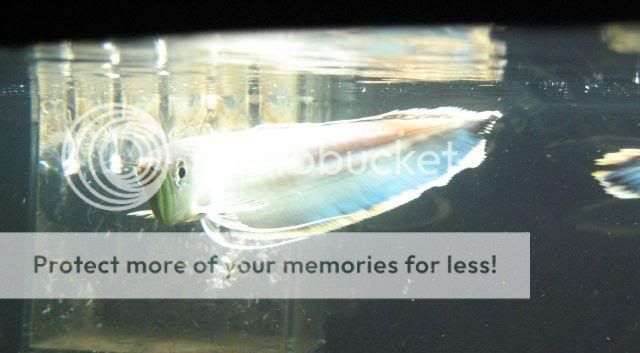Common name/s: Silver Arowana, Arahuana, Aruana, Arrowana, Arawana
Scientific name: Osteoglossum Bicirrhosum
Family: Osteoglossidae
Origin: Brazil, Peru, Amazon river basin and the still waters of Guyana.
Maximum size: 36" to 40"
Care: Minimum tank size of 180 gallons which can house young specimens, but as it grows, a larger tank will be necessary to prevent deformities and to ensure the maximum length and life span of the animal. At full size an adult Silver Arowana should have a tank of approximately 300 gallons. Soft and acidic (pH 6.0-6.9) water of 24 to 28 centigrade (75-82f) is recommended and the tank has to be well filtered. As with all large predatory fish weekly water changes of 30 to 40% are recommended. Because of the huge adult size of the Silver Arowana, and it being an aggressive predator, there are very few common aquarium species that can be kept with this fish. Tankmates have to be large and robust. In the wild, this fish survives by jumping for its food which includes insects and small birds as a result of this, the tank must be kept covered at all times and even weighted down as the fish grows.
Do take note that a tank too small and could result in stunting the fish, which would lead to the possibility of causing it to have gill curl. Gill curl is a condition where the gills of the Arowana will curl outward, and it results from the fish having to swim backwards due to an insufficient tank size. Silver Arowanas in particular, act very uncomfortable in bare tanks. They might knock some of their decor around, but they act much calmer in a decorated tank. Feel free to add live plants into the tank, perferably to both ends. Most species of Arowanas, if not all, do not eat vegetation. Plants may be knocked loose from time to time, but this is however by accident rather than intentionally.
Feeding: Will usually accept dead meaty foods such as cockles, mussels, prawns, whitebait etc, or even floating pellets. Live fish and crickets are particularly favoured. "Gut loading" crickets with vegetables or fish flakes would provide additional nutrition to your Silver Arowana.
Sexing: Mature females are much larger in circumference and the anal fin is not as long as the males.
Breeding: A paternal mouthbrooder. When spawning, the pair swims around in circles and the female will lay her orange eggs, about the size of 8-12mm and then the male will fertilize them. The quantity of eggs laid range from anywhere between 50-250. The male holds a small clutch of large eggs in a brood pouch in his mouth and broods the larval fish for a further three weeks. At a size of 3-4cm the fish are released to allow them to feed but return to the male's mouth if danger threatens. The fish leave the mouth at an age of 4-6 weeks when they measure around 10cm/4" in length.
Comments: Often sold as juveniles and buyers are not aware of their potential size. Not a beginner fish due to its large tank requirements and high protein diet which leads to high nitrate and ammonia build up. Many people like having more than one Arowana in the tank; in this case, it is recommended to keep at least 5 to 6 in the tank at a time because Silver Arowanas are very aggressive towards each other.
Younger Silver Arowanas perfer still water. When there are no ripples, they will cruise the water surface, and are hence very sensitive to water disturbances. Shortly before their yolk sacs are fully absorbed, Silver Arowanas will readily accept small insects like young crickets and wingless fruit flies. It is noted that when fed insects, they tend to ignore feeder fish. This tendency continues through adulthood, and they will only eat fish if there isn't a choice. It is however important to note that in a tank with still water, Silver Arowanas are very territorial, and one dominant fish will kill its siblings or drive them to lower depths to starve, if they are not removed.
Many times, Silver Arowanas are found in shops when they still have the egg sac attached, meaning that they have been forcibly removed from the father and can be very difficult to raise due to their young age and rough removal. In my opinion, avoid buying young Silver Arowanas with the sac still attached unless you are a confident and experienced carer or breeder of Silver Arowanas. To go an extra mile, you could notify the shop keeper on your disappointment about the young Silver Arowanas.

Scientific name: Osteoglossum Bicirrhosum
Family: Osteoglossidae
Origin: Brazil, Peru, Amazon river basin and the still waters of Guyana.
Maximum size: 36" to 40"
Care: Minimum tank size of 180 gallons which can house young specimens, but as it grows, a larger tank will be necessary to prevent deformities and to ensure the maximum length and life span of the animal. At full size an adult Silver Arowana should have a tank of approximately 300 gallons. Soft and acidic (pH 6.0-6.9) water of 24 to 28 centigrade (75-82f) is recommended and the tank has to be well filtered. As with all large predatory fish weekly water changes of 30 to 40% are recommended. Because of the huge adult size of the Silver Arowana, and it being an aggressive predator, there are very few common aquarium species that can be kept with this fish. Tankmates have to be large and robust. In the wild, this fish survives by jumping for its food which includes insects and small birds as a result of this, the tank must be kept covered at all times and even weighted down as the fish grows.
Do take note that a tank too small and could result in stunting the fish, which would lead to the possibility of causing it to have gill curl. Gill curl is a condition where the gills of the Arowana will curl outward, and it results from the fish having to swim backwards due to an insufficient tank size. Silver Arowanas in particular, act very uncomfortable in bare tanks. They might knock some of their decor around, but they act much calmer in a decorated tank. Feel free to add live plants into the tank, perferably to both ends. Most species of Arowanas, if not all, do not eat vegetation. Plants may be knocked loose from time to time, but this is however by accident rather than intentionally.
Feeding: Will usually accept dead meaty foods such as cockles, mussels, prawns, whitebait etc, or even floating pellets. Live fish and crickets are particularly favoured. "Gut loading" crickets with vegetables or fish flakes would provide additional nutrition to your Silver Arowana.
Sexing: Mature females are much larger in circumference and the anal fin is not as long as the males.
Breeding: A paternal mouthbrooder. When spawning, the pair swims around in circles and the female will lay her orange eggs, about the size of 8-12mm and then the male will fertilize them. The quantity of eggs laid range from anywhere between 50-250. The male holds a small clutch of large eggs in a brood pouch in his mouth and broods the larval fish for a further three weeks. At a size of 3-4cm the fish are released to allow them to feed but return to the male's mouth if danger threatens. The fish leave the mouth at an age of 4-6 weeks when they measure around 10cm/4" in length.
Comments: Often sold as juveniles and buyers are not aware of their potential size. Not a beginner fish due to its large tank requirements and high protein diet which leads to high nitrate and ammonia build up. Many people like having more than one Arowana in the tank; in this case, it is recommended to keep at least 5 to 6 in the tank at a time because Silver Arowanas are very aggressive towards each other.
Younger Silver Arowanas perfer still water. When there are no ripples, they will cruise the water surface, and are hence very sensitive to water disturbances. Shortly before their yolk sacs are fully absorbed, Silver Arowanas will readily accept small insects like young crickets and wingless fruit flies. It is noted that when fed insects, they tend to ignore feeder fish. This tendency continues through adulthood, and they will only eat fish if there isn't a choice. It is however important to note that in a tank with still water, Silver Arowanas are very territorial, and one dominant fish will kill its siblings or drive them to lower depths to starve, if they are not removed.
Many times, Silver Arowanas are found in shops when they still have the egg sac attached, meaning that they have been forcibly removed from the father and can be very difficult to raise due to their young age and rough removal. In my opinion, avoid buying young Silver Arowanas with the sac still attached unless you are a confident and experienced carer or breeder of Silver Arowanas. To go an extra mile, you could notify the shop keeper on your disappointment about the young Silver Arowanas.


